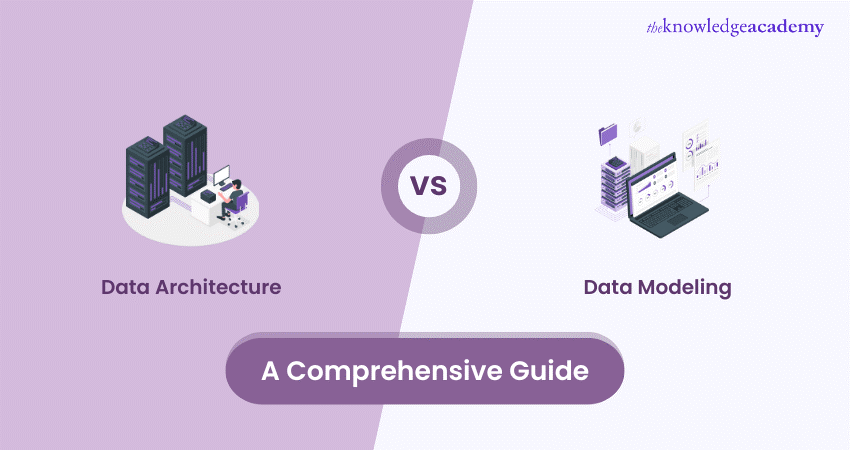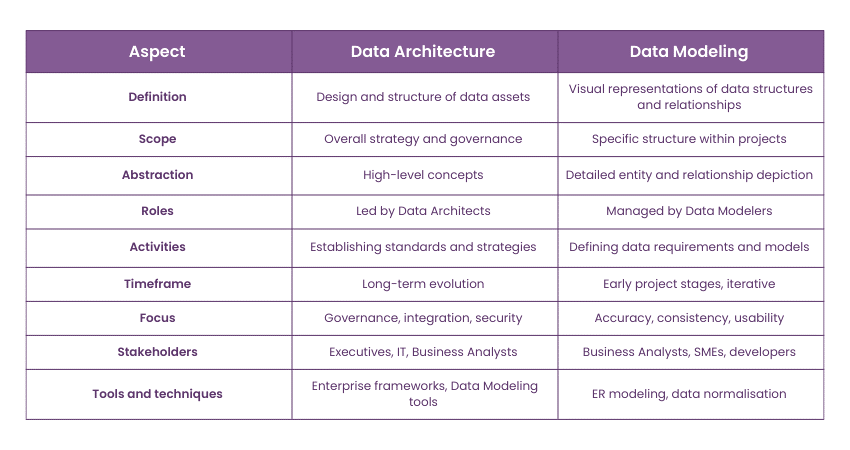We may not have the course you’re looking for. If you enquire or give us a call on 01344203999 and speak to our training experts, we may still be able to help with your training requirements.
Training Outcomes Within Your Budget!
We ensure quality, budget-alignment, and timely delivery by our expert instructors.

Do you often get confused between Data Architecture and Data Modeling? Don’t know how you can improve your skill sets to help your organisation improve their business operations and data infrastructure? We are here to help you through this blog. In this blog, we will address the differences between Data Architecture vs Data Modeling so that you can learn to better utilise and manage data.
Table of Contents
1) What is Data Architecture?
2) What is Data Modeling?
3) Difference between Data Architecture and Data Modeling
a) Definition
b) Scope and abstraction
c) Roles and responsibilities
d) Included activities
e) Levels of abstraction
f) Timeframe and granularity
g) Focus areas
h) Tools and techniques
i) Stakeholders
4) Conclusion
What is Data Architecture?
The Data Architecture of an organisation is a bigger concept that includes the layout of data assets such as databases, data warehouses, and data lakes. The way data is collected, stored, and processed, and the access rights to the information, are determined in accordance with the businesses’ requirements.
Data Architecture aims to create designs supported by plans that safeguard data accuracy, security and expandability. It addresses critical issues, including building controls, policies, and data governance and management processes. By setting up efficient Data Architecture, organisations can have better resources for data utilisation, a decisive process of decision-making and planning for future strategies through data handling and analytics.
What is Data Modeling?
Data modeling is creating visual or mathematical representations to depict data structures, connections, and attributes so that they can be easily understood and shared. The RDBMS works by specifying the entities, their attributes and the relationship between them. It arranges and organises them logically and consistently. Data models can be conceptual, logical, and physical, and they serve different roles in developing, deploying, and exploiting data.
Using data modelling techniques, organisations can make requirements clear, discover trends and exhibit designs of databases or systems that will logically store and retrieve data. Data Modeling is critical in database design, software development, and decision-making processes related to data management and analytics.
Difference between Data Architecture and Data Modeling
Let’s look at some differences between Data Architecture and Data Modeling:

Definition
Data Architecture is the design and the structure of an organisation's data assets, such as databases, data warehouses and data lakes. It involves designing data management, governance and utilisation blueprints, while Data Modeling involves creating visual or mathematical representations of data structures, attributes and relationships to improve understanding and communication. It defines entities, attributes and relationships between them logically.
Scope and abstraction
Data Architecture involves the creation of an overall design and careful organisation of data systems, which focuses on high-level concepts, such as data governance, data integration, etc., but Data Modeling focuses on the relationships and structure of data elements. These elements reside within a specific domain or project, which provides a detailed representation of data entities and their attributes.
Roles and responsibilities
Data Architecture, designed and implemented by Data Architects, provides the organisation with the strategy and methodology needed for implementing the organisation's Data Architecture. Architects in these fields are also required to work with various stakeholders to refine the requirements and the fitting of the purpose to those of the business.
The main difference is that Data Modelling or Data Modelers will produce and manage Data Models, which depend on the organisation’s business requirements. The Modelers are in constant communication with the Business Analysts, Database Administrators, and Developers, and they ensure that the Data models are precise and operational.
Elevate your expertise in benefits management and business acceptance with our BCS Practitioner Certificate in Benefits Management and Business Acceptance Course – sign up today!
Included activities
The activities included in Data Architecture define data standards, establish data governance policies and design data storage solutions. Developing data integration strategies is also one of the most essential activities in Data Architecture.
On the contrary, Data Modeling includes activities that help identify data requirements and create conceptual, logical, and physical data models. Other activities include performing data normalisation and validating data models against business rules.
Levels of abstraction
The Data Architecture deals with underlying data processing at the abstract level, concentrating on the data strategy and governance policy for an entire enterprise. It presents general principles and architecture that are used to guide the entire organisation's data management practices.
Data Modeling includes several levels of abstraction: conceptual, logical, and physical Data model levels. The levels get progressively complex and detailed in explaining the available information, the data elements and how they relate.
Master the fundamentals of IS Project Management with our BCS Foundation Certificate in IS Project Management Course – register now!
Timeframe and granularity
Data Architecture is usually laid out at the start of the project and developed gradually as the project progresses. The plan considers both short—and long-term goals with strategic objectives that are flexible and adaptable for growth.
On the other hand, Data Modeling is done at the beginning of a project to determine the data requirements and design the data structures. It involves iterative refinement and adjustment based on changing business needs and project requirements.
Focus areas
Data Architecture focuses on the more comprehensive elements, including data governance, data security, data integration, and data across the lifecycle. It covers the overarching management of all the data assets within the organisation and the details of their use.
People apply Data Modeling to an area, application, or project, meaning they pay attention to the detailed structure and relationships between the data elements within these contexts. The prime purpose of mastering data management is to establish a single source of truth by checking the data accuracy, consistency, and fluency for unique business needs.
Tools and techniques
Data Architecture uses business analysis tools such as enterprise architecture frameworks (like TOGAF), Data Modeling tools, metadata management systems, and governance platforms. Based on their architecture, these systems are further classified into centralised and distributed systems. Techniques include Data Modeling, data profiling, data lineage analysis, and data quality management, which is one of the key aspects to include in Data Architecture.
Conversely, Data Modeling tools dictate the extent and the output of the same (for example, ERwin and IBM InfoSphere Data Architect or open-source tools for MySQL). Techniques that are employed include entity-relationship modeling, dimensional modeling or just normalisation.
Stakeholders
Data Architecture requires developing the competency of various stakeholders and fully engaging executives, business analysts, IT professionals, and compliance officers on the same platform. It involves the analytics team partnering with others to schedule these tasks in line with business goals.
Even though Data Modeling involves a high number of stakeholders like business analysts, knowledge crunchers, database administrators, and developers. In Data Modeling cooperation with business users is crucial, that is why it is important to focus on understanding what data requirements they have and how the Data Models can comply with user's needs.
Conclusion
While Data Architecture and Data Modeling are related concepts within the broader field of data management, they serve distinct purposes and involve different activities, roles, and stakeholders. We hope that from this blog you have understood the distinction between Data Architecture vs Data Modeling and how you can utilise and manage data to improve your organisation's business operations.
Unlock the power of user-centric design with our BCS Foundation Certificate in User Experience Course!
Frequently Asked Questions

The three types of Data Architecture are Enterprise Data Architecture, Information Architecture, and Solution Data Architecture.

Designing Data Architecture involves:
a) Defining business requirements
b) Identifying data sources and stakeholders
c) Creating conceptual, logical, and physical data models
d) Establishing data standards and governance
e) Selecting appropriate technologies and platforms
f) Implementing data storage, integration, and management solutions.

The Knowledge Academy takes global learning to new heights, offering over 30,000 online courses across 490+ locations in 220 countries. This expansive reach ensures accessibility and convenience for learners worldwide.
Alongside our diverse Online Course Catalogue, encompassing 17 major categories, we go the extra mile by providing a plethora of free educational Online Resources like News updates, Blogs, videos, webinars, and interview questions. Tailoring learning experiences further, professionals can maximise value with customisable Course Bundles of TKA.

The Knowledge Academy’s Knowledge Pass, a prepaid voucher, adds another layer of flexibility, allowing course bookings over a 12-month period. Join us on a journey where education knows no bounds.

The Knowledge Academy offers various Business Analysis Courses , including BCS Certificate In Business Analysis Practice Training, CS Practitioner Certificate in Requirements Engineering Course, and BCS Practitioner Certificate in Modelling Business Processes Training. These courses cater to different skill levels, providing comprehensive insights into Essential Business Analyst Skills.
Our Business Analysis blogs covers a range of topics related to Business Analysis, offering valuable resources, best practices, and industry insights. Whether you are a beginner or looking to advance your Business Analysis skills, The Knowledge Academy's diverse courses and informative blogs have you covered.
Upcoming Batches & Dates
Date








 Top Rated Course
Top Rated Course



 If you wish to make any changes to your course, please
If you wish to make any changes to your course, please


